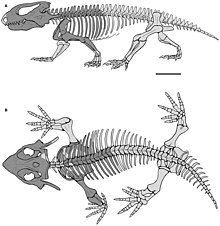Kapes (genus)
| Kapes Temporal range: Lower - Middle Triassic
| |
|---|---|

| |
| Skeleton of Kapes bentoni | |
| Scientific classification | |
| Domain: | Eukaryota |
| Kingdom: | Animalia |
| Phylum: | Chordata |
| Class: | Reptilia |
| Clade: | †Parareptilia |
| Order: | †Procolophonomorpha |
| Family: | †Procolophonidae |
| Subfamily: | †Procolophoninae |
| Genus: | †Kapes Ivakhnenko, 1975 |
| Species | |
| |

Kapes is an extinct genus of procolophonid parareptile from the Lower and Middle Triassic of Russia, Spain and the United Kingdom. The type species K. amaenus was named in 1975 from the banks of the Vychegda River in the Komi Republic of Russia. In 1983, a new species was brought into the genus, K. majmesculae. K. majmesculae was first named in 1968 as a member of the genus Tichvinskia. A third Russian species, K. serotinus, was named in 1991. In 2002, Kapes bentoni was described from the Middle Triassic Otter Sandstone Formation of Devon, England, extending the geographic range of Kapes. In the same paper, K. serotinus was synonymized with K. majmesculae and another Russian species was assigned to Kapes called K. komiensis. K. komiensis was first named in 1975 (in the same paper K. amaenus was named in) as a member of the genus Macrophon.[1] In 2025, Kapes signus was described from the Middle Triassic of Catalonia, Spain.[2]
Description
[edit]Medium to large parareptiles. The validity of the genus is based mainly on dental characteristics. On the upper jaw there are four to five molariforms, one of which, placed middle, is mesial. A very large tooth located on the lower jaw. First four molariforms enlarge towards the posterior ends of the upper and lower jaws. Labial and lingual cusps on the lower teeth are almost the same height and located close to each other.[3] Kapes differs from Tichvinskia by being larger and the number and shape of the teeth.[3]
Phylogeny
[edit]It was defined as a member of the subfamily Procolophoninae by Cisneros et al. (2008).[4] Below is a cladogram from Ruta et al. (2011) showing the placement of Kapes within this subfamily:[5]
| Procolophonidae |
| ||||||||||||||||||||||||||||||||||||||||||||||||||||||||||||||||||||||||
In their phylogenetic analyses, Butler et al. (2023) placed two Kapes species, K. bentoni and K. majmesculae, in Leptopleuroninae or in Procolophonidae, outside of both Leptopleuroninae and Procolophoninae.[6]
References
[edit]- ^ Spencer, P. S.; Storrs, G. W. (2002). "A Re-evaluation of Small Tetrapods from the Middle Triassic Otter Sandstone Formation of Devon, England". Palaeontology. 45 (3): 447. Bibcode:2002Palgy..45..447S. doi:10.1111/1475-4983.00245.
- ^ Riccetto, M.; Mujal, E.; Bolet, A.; De Jaime-Soguero, C.; De Esteban-Trivigno, S.; Fortuny, J. (2025). "Tooth morphotypes shed light on the paleobiodiversity of Middle Triassic terrestrial vertebrate ecosystems from NE Iberian Peninsula (southwestern Europe)". Rivista Italiana di Paleontologia e Stratigrafia. 131 (1). doi:10.54103/2039-4942/22340.
- ^ a b P. S. Spencer, M. J. Benton. Procolophonids from the Permo-Triassic of Russia (in The Age of Dinosaurs in Russia and Mongolia) (PDF). Cambridge University Press. pp. 168–170. Archived (PDF) from the original on May 9, 2023.
- ^ Cisneros, J. C. (2008). "Phylogenetic relationships of procolophonid parareptiles with remarks on their geological record". Journal of Systematic Palaeontology. 6 (3): 345–366. Bibcode:2008JSPal...6..345C. doi:10.1017/S1477201907002350. S2CID 84468714.
- ^ Ruta, M.; Cisneros, J. C.; Liebrecht, T.; Tsuji, L. A.; Müller, J. (2011). "Amniotes through major biological crises: Faunal turnover among Parareptiles and the end-Permian mass extinction". Palaeontology. 54 (5): 1117. Bibcode:2011Palgy..54.1117R. doi:10.1111/j.1475-4983.2011.01051.x.
- ^ Butler, R. J.; Meade, L. E.; Cleary, T. J.; McWhirter, K. T.; Brown, E. E.; Kemp, T. S.; Benito, J.; Fraser, N. C. (2023). "Hwiccewyrm trispiculum gen. et sp. nov., a new leptopleuronine procolophonid from the Late Triassic of southwest England". The Anatomical Record. 307 (4): 1390–1420. doi:10.1002/ar.25316. PMID 37735997.


